Antarctic
Icebergs
This is an iceberg taken from the air that is stuck in sea ice. We were about 200 feet above the deck at this point and I loved the arch in the berg.
Icebergs are quite distinct from sea ice because they derive from the glaciers that cover the Antarctic continent. Glaciers are vast ice sheets that grow from snow accumulation on the landmass and spread outwards until their edges push into the sea. There are ice sheets that are less dense than seawater, are buoyed by the water and break up under the stress of current, wind, and wave action. Calving of the berg off the glacier is quite amazing to see and hear and is something I have to be warry of when operating the RIBs around the glaciers around base – Sheldon.
The edge of glaciers down here form shelf ice which push into the marginal seas around the continent and can exceed 60 miles long and over 650 feet above sea level. In 1991 an iceberg the size of Connecticut broke loose from an ice shelf in the Weddell Sea. Most calving occurs during the summer when the sea ice breaks up and ocean swells can reach the shelf ice the icerbergs that calve move north into warmer rougher waters and disintegrate.
Dreary weather but still a fun weekend
Saturday was a normal day of work with marine life disrupting diving so instead there was more crew training and CTD. In the afternoon I made some sugar cookies for smoko this week and showed one of the Board members who came down on the Dash around the boatshed. Claire made brownies for Helen’s 30 birthday and I helped out a little in the kitchen as it was the Air Mechs BBQ and Clive was on Gash.
Claire and I headed up the hill for an hour and half of nordic skiing skinning up the ramp to work off all the food we were going to wolf down at the BBQ.
We all got dressed to go across to the hanger in our best insulated boiler suits! I wore my black little number as orange isn’t really my color!
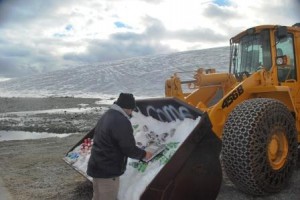
The bar Rothera style – no need for ice!
Ant and Tristan
The band was excellent as usual and had practiced 4 different Ceilidh dances. Alan (the chief pilot) had for the first time in history removed the planes from the hanger and put them on the apron so that the hanger became our dance floor.
So Helen had a great 30th birthday party albiet a little chilly but after doing one or two dances people took off their boiler suits.
The fire in the BBQ was really nice to stand by and smell the wood burning – something I miss is a good fire at home. At midnight it was time to head home across the runway and it really was a beautiful sunset.
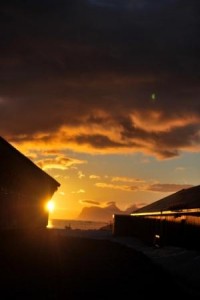
Liothyrella uva – Brachipods
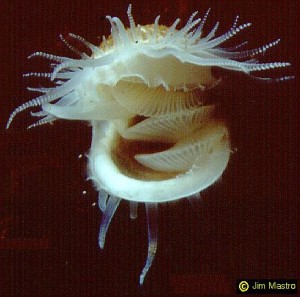
Terri and I dove off the wharf at the beginning of January for these brachiopods at about 27m on the wall that is right at the wharf. The depth drops away very quickly to 300m plus within a 1/2km.
They are benthic organisms that are attached by a pedicle so they have to be cut off the rocks they are attached to. I declined to do that as I didn’t want to wreck the animal so I searched for them and when I found some I would call Terri over to do the honors – I found one bunch of about 5.
They defend themselves chemically from many predators and also are protected by their shells. There aren’t many of them and the ones we were taking were about 80 years old. Their shells are similar to growth rings in trees with growth lines and they can tell us historic information about climatic events in the last few decades.
Brachiopods are also called lamp shells because they resemble early Roman oil lamps. Brachiopods occur in all oceans and, though no longer numerous, were once one of the most abundant forms of life.
Nunatak
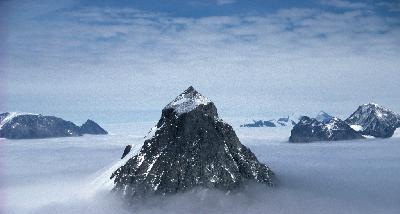
(a Greenlandic word): An exposed summit of a ridge mountain or peak (not covered with snow) within an ice field or glacier. These stunning features occur in the most remote beautiful yet fragile and threatened environments on our planet.
Thelepus Cincinnatus – worms with spider webs!
On the Leonie dive at the beginning of January I saw lots of these with Dave and have since noticed them quite a lot. They are collected for food in the aquarium and also for reproductive studies. This study is done back in the UK so they get set back for their gonads to be dissected. They are polychaete worms that live in their casts in the sediment. What you see is their spider web tentacles over the top of everything. To collect them you dig into the sediment and put the handful of sediment and hopefully the worm into the collection bag. It is hard to get a picture of them unfortunately.
At Work – Terri and CTD
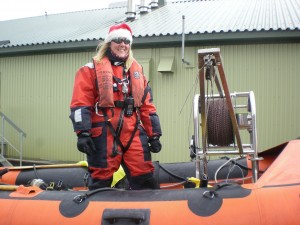
Terri is the Marine Assistant here at Rothera she is from South Africa and is down here for 2.5 years. This picture is of her on the CTD boat Terra Nova. CTD casts provide data on conductivity (which can be converted to salinity), pressure (which equates to depth) and temperature. At the same time the flourometer provides data on total chlorophyll biomass, and the PAR (photosynthetically active radiation) sensor on the underwater light climate. The CTD instrument is deployed to 500m using a winch, which is mounted on Terra Nova.
As well as CTD twice a week she is in charge of the sediment panels, loggers and does collections. She has done over 130 dives at Rothera.
Sea Ice
This is a picture of sea ice from the plane when I went to help with the Magic Project of taking pictures of emperor pengions from 2500 feet.
Sea ice is a mass of frozen seawater that forms aroudn the margins of Antarctica. Pure water freezes at 0C however, seawater with a salinity of 35 parts per thousand is -1.91C. As water freezes at the ocean surface, the dissolved solids cannot fit into the crystalline structure of the ice so the salts are left behind to dissolve in surrounding sea water. The density and salnity of the surrounding water therefore increases and the greater salinity lowers the freezing point of the remaining water. The denser lower temperature water not in the ice sinks replaced by warmer less dense water creating circulation that enhances the formation of sea ice. Freezing is aided by low salinity and calm water conditions.
Sea ice forms as small needlelike crystals of a hexagonal shape eventually creating a slush that forms into a thin sheet broken by wind and waves creating disc shaped pancake ice. As furter freezing occurs the pancakes form ice floes. The rate at which this occurs is temperature dependant. Brine channels form in the sea ice but as it gets older these disperse and the ice becomes more pure.
Orca
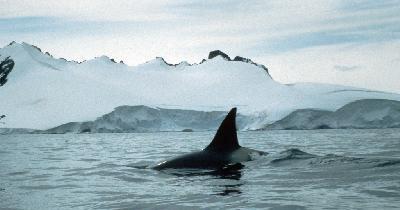
Orcinus orca in North Cove Rothera
Orca or Killer whales are the largest members of the dolphin family with the maximum length being recorded at 32 feet. They live for 35-50 years and weigh up to 11 tonnes. Due to their formidable array of teeth and that they hunt in pods they are at the very top of the Antarctic food chain. They eat everything from krill, squid, fish and sharks to penguins, seals and even the much larger baleen whales. Learn more here
There is a pod of about 10 that comes back to Rothera each year and they will swim right past the wharf as the water drops to 350meters within 50meters of the wharf. They are another member of marine life that means we have to stop diving for four hours after a siting. Once you have seen their fins it is easy to tell the difference between them and Minke Whales.
The pod of Orcas that comes to Rothera has distinctive marks on their fins that the winters immediately recognized when they made their first apperance back this season. Normally they are seen by the guys up in the ops tower (our air traffic tower) will see them first way out in the bay or seal watch will see them and an all stations call will go out on the VHF. As it is normally at South Cove or the wharf everyone on station runs down to the south part of the station with cameras running or on gators to take pictures.
The other day I was on seal watch and saw them about 2.5km out towards Leonie the dive boat had just gone in the water and asked where I had seen them. The orca surfaced behind the dive boat just as they radio asking me where they were – it was fun to say ‘look behind you’ ! The Orca went under the boat and came up the other side so despite losing the dive there were lots of smiles.
The last few days there has been a lot of Orca and Minke whale activity so diving has been very limited with the four hour rule in effect however, quite a few boat trips for science have been extended for some whale watching!
Crevasses
We have a crevasse at the top of the ramp which has ropes allowing us to go for trips down inside of it and thru the cave system.
What this really drives home when you look up to the top of the cave and see the snow bridges is how careful you need to be when doing fieldwork. Crevasses are a constant threat on glaciers and are the greatest danger to field parties down here.
The movement of glaciers flowing downhill creates crevasses when the brittle surface layer (50-80m) is subject to forces such as change in angle or speed of flow. Glaciers in Antarctica are usually covered by several feet of snow making it difficult to see what is happening below the surface.
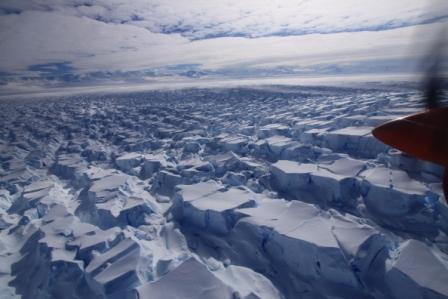
Crevasses tend to appear in similar places on any given glacier and can occur long distances downstream of the features that cause them. The causes of stresses on the brittle surface layer are:
1) Shape of slope – Convex slopes are more likely to be crevassed than concave slopes compression is a good thing and tension is a bad thing as it causes cracking.
2) Speed of flow
3) Glacier shape
4) Type of glacier
In areas where no crevasses are visible you will have to predict their likely position and orientation. Knowing the orientation of crevasses is as important as spotting where they are. The presence of crevassing is often marked by slumped snow bridges showing up as a faint linear depression.
So we learnt in field training how to rope up and use the necessary equipment to rescue someone from a crevasse. Crevasse bridges can be appreciably weaker in the late afternoon after the sun has warmed the snow. So during the summer travelling at night could be preferable at the end of the winter the bridges are obviously stronger due to maximum snow cover and lower temperatures.
Sea Lemons
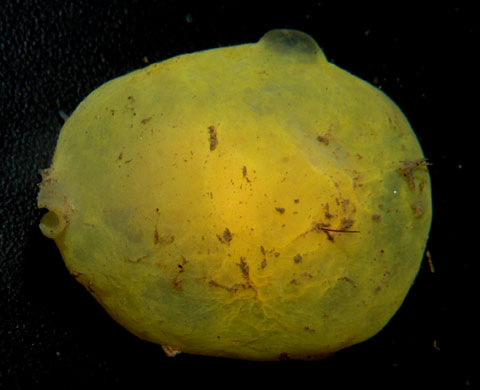
A picture of a Sea Lemon (marseniopsis mollis) a kind of Mollusc as the shell is internal.
We collect them to go into the aquarium where they are used to address the question
We kept our animals in enormous aquariums until we needed them for research. One of the research questions we address is the temperature range these animals could withstand so they are taken to their thermal limits and weighed wet and dry. Normally the temperature in the waters around Antarctica is a very stable low temperature (-1.8 to 2 degrees Celsius). It is important to explore whether animals can adapt to higher temperatures because of global warming.

